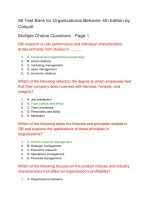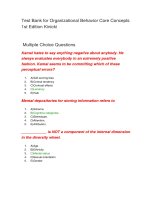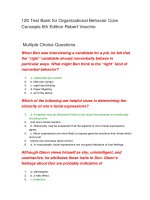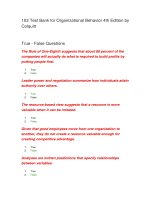Organizational behavior core concepts by kinicki chapter4
Bạn đang xem bản rút gọn của tài liệu. Xem và tải ngay bản đầy đủ của tài liệu tại đây (470.52 KB, 42 trang )
4
Organizational Behavior
core concepts
Motivation in Theory: What
Makes Employees Try
Harder
4-2
McGraw-Hill/Irwin
Organizational Behavior, Core Concepts
Copyright © 2008 by the McGraw-Hill Companies, Inc. All rights reserved.
Learning Objectives
• Describe how individuals may be
motivated by their needs
• Discuss how individuals may be
motivated by their perceptions of equity
and justice
• Summarize how people’s motivation can
be influenced by their attitudes toward
outcomes and their belief they can
influence outcomes
4-3
Learning Objectives
• Explain how goal setting motivates
individuals
• Review ways to design jobs so as to
influence employee motivation
4-4
Motivation in Theory
• Motivation
– psychological processes that arouse and
direct goal-directed behavior
4-5
Motivation in Theory
• Content theories
– identify internal factors such as instincts,
needs, satisfaction, and job characteristics
that energize employee motivation
• Process theories
– explain the process by which internal factors
and cognitions influence a person’s
motivation
4-6
Content Theories of Motivation
• Needs
– Physiological or psychological
deficiencies that arouse behavior.
4-7
Maslow’s Need Hierarchy Theory
• Motivation is a function of five basic
needs – physiological, safety, love,
esteem, and self-actualization
• Arranged in a preponent hierarchy
4-8
Maslow’s Need Hierarchy
Figure 4-1
4-9
Maslow’s Need Hierarchy Theory
• Once a need is satisfied it activates the
next higher need in the hierarchy
• Managerial implication – a satisfied need
may lose its motivational potential
4-10
Alderfer’s ERG Theory
• Existence needs
– desire to have physiological and materialistic
well-being
• Relatedness needs
– desire to have meaningful relationships with
significant others
• Growth needs
– desire to grow as a human and use one’s
abilities to their fullest
4-11
Question?
What need is the desire to accomplish
something difficult?
A. Affiliation
B. Achievement
C. Power
D. Glory
4-12
McClelland’s Need Theory
• Need for achievement
– Desire to accomplish something difficult.
• Need for affiliation
– Desire to spend time in social relationships
and activities.
• Need for power
– Desire to Influence, coach, teach, or
encourage others to achieve.
4-13
McClelland’s Need Theory
Achievement-motivated people share three
common characteristics:
1. Preference for working on tasks of
moderate difficulty
2. Preference for situations in which
performance is due to their efforts
3. Desire more feedback on their
successes and failures
4-14
McClelland’s Need Theory:
Managerial Implications
• Organizations should consider the
benefits of providing achievement
training for employees
• Achievement, affiliation, and power
needs can be considered during the
selection process, for better placement
• Managers should create challenging task
assignments or goals
4-15
Herzberg’s Motivator-Hygiene
Model
• Motivators
– job characteristics associated with job
satisfaction
• Hygiene factors
– job characteristics associated with job
dissatisfaction
4-16
Equity Theory
• Equity theory
– Holds that
motivation is a
function of fairness
in social
exchanges
4-17
Negative and Positive Inequity
• Negative inequity
– Comparison in which another person
receives greater outcomes for similar inputs.
• Positive inequity
– Comparison in which another person
receives lesser outcomes for similar inputs.
4-18
Negative and Positive Inequity
4-19
Figure 4-2
Dynamics of Perceived Inequity
• Equity sensitivity
– An individual’s tolerance for negative and
positive equity
4-20
Dynamics of Perceived Inequity
• Benevolents have a higher tolerance for
negative inequity.
• Sensitives adhere to a strict norm of
reciprocity and are quickly motivated to
resolve both negative and positive
inequity
4-21
Dynamics of Perceived Inequity
• Entitleds have no tolerance for negative
inequity
– expect to obtain greater output/input ratios
than comparison others and become upset
when this is not the case.
4-22
Organizational Justice
• Distributive justice
– The perceived fairness of how resources
and rewards are distributed.
• Procedural justice
– The perceived fairness of the process and
procedures used to make allocation
decisions.
• Interactional justice
– Extent to which people feel fairly treated
when procedures are implemented.
4-23
Practical Lessons from Equity
Theory
• Equity theory provides managers with yet
another explanation of how beliefs and
attitudes affect job performance.
• Research emphasizes the need for
managers to pay attention to employees’
perceptions of what is fair and equitable.
4-24
Practical Lessons from Equity
Theory
• Managers benefit by allowing employees
to participate in making decisions about
important work outcomes.
• Employees should be given the
opportunity to appeal decisions that
affect their welfare.
4-25









